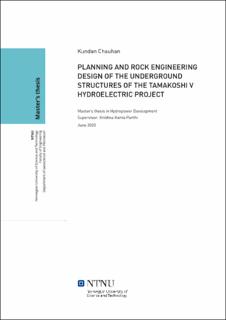| dc.description.abstract | The Tamakoshi V Hydroelectric Project is a cascade scheme of the under construction 456 MW Upper Tamakoshi Hydroelectric Project. It has an installed capacity of 99.8 MW and will be located in the right bank of Tamakoshi river in Dolakha District, Nepal (NEA 2019).
Evaluation of the existing layout of Tamakoshi V shows that Headrace Tunnel (HRT) and Tailrace Tunnel (TRT) are safe with respect to the major joint sets including foliation joints. However, due to unfavorable orientation of one of the discontinuities in Powerhouse cavern, alternative alignment for Powerhouse has been proposed considering major joint sets and tectonic stress direction. The potentiality of exploiting HRT of Tamakoshi V as shotcrete lined pressure tunnel has been assessed based on Rock engineering assessment, Norwegian Confinement Criteria (NCC), Modified NCC, In-situ stress state assessment and Leakage assessment. It has been found that HRT downstream (d/s) of chainage 5+000m is vulnerable to hydraulic jacking and the leakages compared to HRT upstream of it. However, after implementing pre-injection grouting at the vulnerable sections and assuring long term stability, HRT of Tamakoshi V can be designed as shotcrete lined pressure tunnel.
Due to variation in stresses and rock types along the alignment, different potential stability problems have been assessed using empirical, semi-analytical and numerical modelling methods (RS2). Potential block fall at chainage 5+025m can be avoided using spot or sparsely spaced pattern bolting. Brittle failure analysis shows spalling potential in the Banded gneiss section, which can be controlled by the application fiber reinforced shotcrete (Sfr) and bolt (B). In deformation analysis, squeezing problem ranging from few support problems to extreme squeezing has been assessed in the rock masses d/s of chainage 1+769m. At chainage 3+769m in Tatopani weakness/shear zone, total tunnel strain of 26.6% has been evaluated. This can be controlled by providing early confinement or pre-reinforcement in tunnel periphery and near face prior to excavation, and with application of support systems consisting of Reinforced Ribs of Shotcrete, bolts and invert concrete. Likewise, deformation on the remaining sections along the HRT and TRT can be maintained within 5% strain with support system of fiber reinforced shotcrete, bolts and invert concrete. With these measures, long-term stability problem along the HRT can be assured, which is one of the important requirements for the implementation of shotcrete lined pressure tunnel. Also, Powerhouse cavern has been assessed both statically and dynamically with earthquake load, which shows insignificant problems in the suggested support (cable bolt, fiber reinforced shotcrete and bolt), rock mass and in-situ stress. | |
